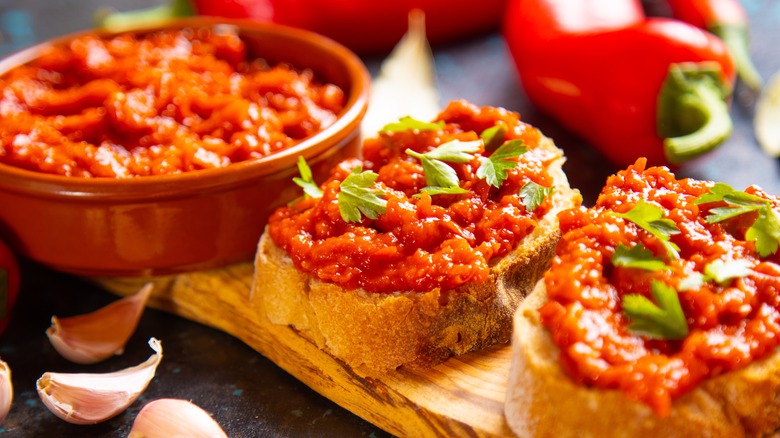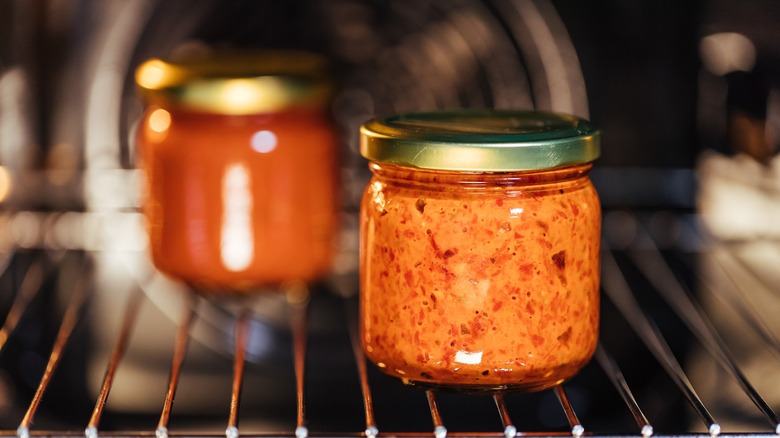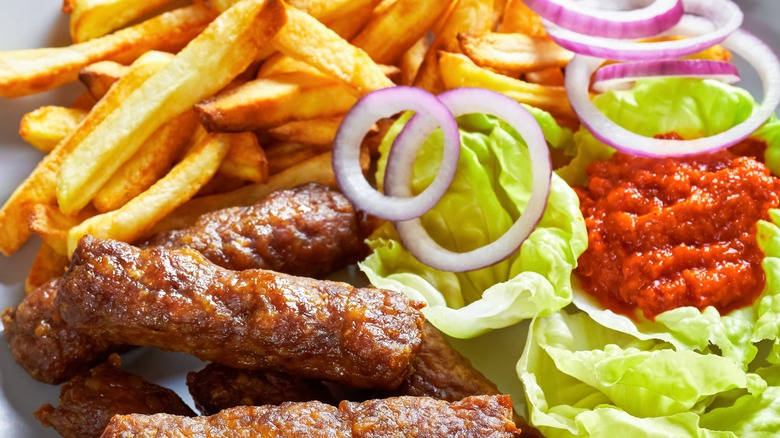What Is Ajvar And Is It A Sauce Or A Relish?
Balkan cuisine may be known more for its grilled meats and thick, salty cheeses than for its veggies, but there is a beloved Balkan vegetable relish (yes, relish not sauce) that should definitely be in your pantry at any time of the year: ajvar. This condiment — native to Serbia, Bosnia and Herzegovina, and North Macedonia – is made from grilled red bell peppers and eggplant, which are then skinned and blended with olive oil, garlic, and just a dash of vinegar. Of course, there are as many variations as there are people who make it.
The origins of ajvar are somewhat unknown, but it's assumed that it was developed as an autumn recipe designed to use up end-of-season produce ahead of the winter. It is generally assumed to be Serbian but found its way to many other cuisines in the Balkans around World War II. In fact, the first known published recipe is in a 19th-century Serbian cookbook by Katarina Popović.
The name ajvar comes from the Turkish word for caviar, or havyar, as it was commonly eaten in regions where caviar farming was popular, and eventually was adopted as a sort of poor man's substitute for the delicacy in the late 19th century. This is similar to how many eggplant spreads are still called eggplant caviar – little surprise given eggplant's ability to substitute meat.
Relish or sauce?
While ajvar is often referred to as a relish, this isn't quite accurate. A relish is generally a pickled condiment made from finely chopped fruits or vegetables that retain their original shape and texture after being preserved in vinegar and other spices. Ajvar, on the other hand, is made from cooked red bell peppers and eggplant, which are then blended into a smooth spread. And while it does contain a small amount of vinegar (or sometimes lemon), this is for flavor and not preservation purposes — and the overall flavor is sweet and smoky, not sour. It also doesn't stay shelf stable as relishes do, and it will only last for about a week in the fridge after making.
Ajvar is also commonly referred to as a red pepper sauce, which is closer to the truth. Ajvar has a thick consistency — It won't drip from a spoon; it'll plop. Calling ajvar a spread or condiment is more accurate as it's usually used to dip things like ćevapčići in — or as the final flourish on a meal.
How to use ajvar
This roasted red pepper sauce is easy to make and incredibly versatile. In traditional Balkan cuisine, it is commonly served alongside grilled meats like the Serbian sausage ćevapčići, or with typical Serbian breads like lepinja or pogača. Its thick, spreadable texture means it can stand up to knife-and-fork dishes, but it can also be diluted and used more as a sauce.
Try using ajvar as a sandwich condiment to liven up some Thanksgiving leftovers or as an unexpected secret sauce for your burger. The possibilities are endless. As Wildfare — a Mediterranean food brand that sells the sauce — told Food Republic, "Ajvar can be used as a spread (fabulous slathered on your favorite burger or sandwich). It can happily sit on your charcuterie board as a dip (for crudité, baguette slices, and chips). You can toss it with pasta for a healthy and delicious meal in minutes. It makes a sumptuous bed of sauce for fish, pork, lamb, or your favorite protein. And it also is a spectacular simmer sauce (think chicken paprikash in a snap)."
If you find yourself in a meal rut, with no idea what to make — you just want something straightforward, simple to put together — turn to ajvar. It's a one-stop shop for dinner — or lunch!



